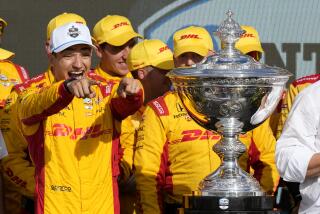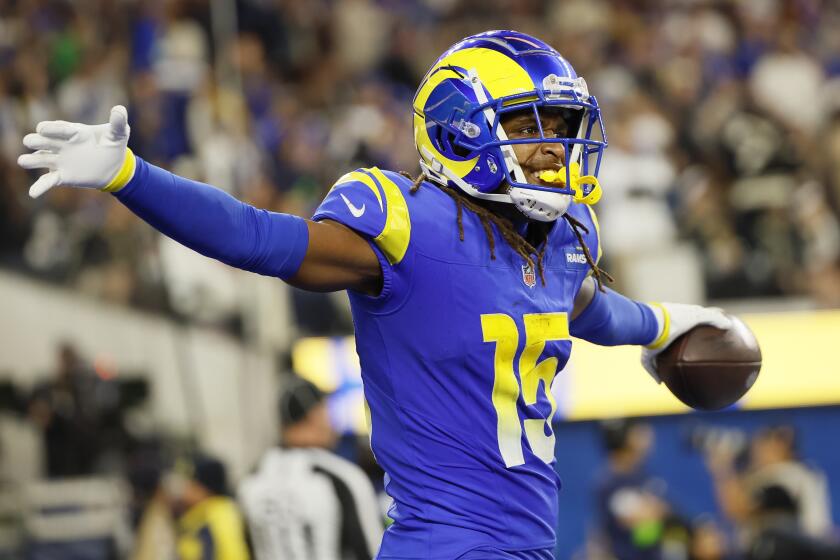Trying to Steer Series Back to Prominence
Can Chris Pook, who performed one miracle in racing more than 25 years ago, perform another this year?
Pook’s announcement last December that he could turn around the moribund Championship Auto Racing Teams, Inc., was met with as much skepticism as his 1975 announcement that he was planning to run a Formula One race down Ocean Boulevard in Long Beach.
The fortunes of CART, once the premier open-wheel racing organization in the country, changed dramatically last year.
Roger Penske moved his high-profile team of series champion Gil de Ferran and Indianapolis 500 winner Helio Castroneves to the struggling Indy Racing League along with CART’s major sponsor, Marlboro; engine suppliers Honda and Ford rebelled when CART announced it would change from turbocharged to normally aspirated engines in 2003 and said they would not furnish engines after this year; a race in Texas was canceled at the last moment because cars were going too fast; the car count dropped to an all-time low and rumors flew that several other CART teams would follow Penske into the IRL next year.
Pook, who turned 61 on April 1, hates to hear or read about things like that.
“Why have so many writers chosen to focus not on what happened at CART in the last few months but on the shortcomings from last season, including a race that was canceled 11 months ago?” he asked. “It seems some of them want to keep CART on the same directionless course it was last year. I can assure you that will not be the case.
“In most cases they champion the greatness of the IRL and the demise of CART, but it should be embarrassing to them when the three opening rounds of the IRL series had attendance in the 10,000 to 15,000 range while our first three races will attract combined three-day crowds of over half a million people.”
It was vintage Pook, stressing the positive despite stressful surroundings, just as he had in 1977 when facing a $1.7-million debt and Bernie Eccelstone refusing to let the Formula One cars run until Pook came up with $300,000 for the purse. He made it, scavenging nearly all night among Long Beach Grand Prix board members.
Again, in 1984, he dropped F1 because of its exorbitant expenses and turned to CART for his spring seaside race. This brought another storm of criticism, much like this year’s, when attendance fell from 82,000 in 1982 to 56,000 in 1984. By 1987, the crowds for the Indy cars were bigger than ever.
“You think this is tough, getting CART up and running,” he said with all the confidence of a man who enjoys the challenge of rising from the brink. “We will turn CART around in much the same way we did the Long Beach Grand Prix 20 years ago.”
In a wide-ranging interview with The Times on the eve of the Toyota Grand Prix of Long Beach, which he founded and presided over for 27 years, the new president and chief executive officer of CART explained his positions.
Question: After four months in your new position, where does CART stand today?
Answer: We’re running on about 71/2 cylinders at the moment, and I expect to have it up to 8 by midsummer.
Q: And how many cylinders were running when you took over Dec. 19?
A: About one.
Q: What makes you think the future is so bright?
A: The original concept of CART is a great product. It is just the best, with a variety of disciplines--road, oval, street and superspeedway--that defines a true champion. There is no better racing product.... The IRL is an oval series running in this country only, we are a multinational series.
Q: What about criticism that CART is a junior version of Formula One, calling itself an American series while holding nine races in six foreign countries?
A: I think it’s terrific. To be associated with Formula One is wonderful. F1 is in a total class of its own. There is no getting away from the fact that ours is a North American series, but we offer our sponsors something no other series can offer, all the benefits of the world’s newly opened trade zones. Mexico, Canada and the United States deliver all the benefits of the NAFTA agreement, we reach the Pacific Rim through our races in Australia and Japan, take advantage of the European Economic Union with events in Germany and Great Britain and hold the gateway to Latin America with our new race in Miami.
Other than adding a St. Petersburg [Fla.] street race next year, we expect to have a stable schedule. This year we added Mexico City, Denver, Montreal and the streets of Miami. We dropped Michigan, Nazareth, Texas and Detroit. It all adds up to a package that is attractive not only to sponsors, teams and drivers but millions of race fans around the world.
Q: What is CART’s status with California Speedway, the only track with both an IRL and a CART race?
A: We have a contract for two more years. We’ve had some attractive races there. I don’t see us leaving.
Q: Why did you wait until last December to take the job of running CART when it was offered to you a year earlier when Bobby Rahal was leaving as temporary CEO and Joe Heitzler was named the new president?
A: A year ago I didn’t feel comfortable with the makeup of the board. It had eight car owners and only three outside directors and quite candidly, it was hard to run a company objectively under that situation. There was too much input by the car owners, all of whom had their own agendas. Not enough members were acting on behalf of the shareholders. Now, the directors have a mandate from the shareholders, led by James Grosfeld, who has a substantial block of CART stock. He put together a strong group of independent board members and they kind of drafted me.
Q: What was the first thing you realized after taking command?
A: No one had been running the store.
Q: What is your position in the suits and countersuits between Heitzler and CART and CART car owners Pat Patrick and Carl Haas in which both sides claim fraud and breach of contract?
A: No comment. What happened happened before my time. As CEO it will be my responsibility to administer findings of the lawsuit, however it winds up. Other than that, I have nothing to say.
Q: What about criticism of a weak television schedule where most of the races will be on Speed Channel, a cable network not available in many areas?
A: The television audience and our 2002 programming schedule is by no means as bleak as some of your lesser informed colleagues have suggested. Although the IRL prefers to focus on our relationship with Speed Channel, they fail to point out, of course, that we have seven races on network television on Fox and CBS. (The Long Beach race will be 12:30 p.m. Sunday on Fox.)
In regards to Speed Channel, it is nothing less than the fastest growing cable network on television. As we position CART for the future, Speed Channel is the perfect partner for combined success. When Fox as a network emerged a few years ago, nobody said they could touch the big three networks. They did. A few years later, Fox introduced the Fox News Channel and the popular wisdom was that little impact would be made on CNN. Fox News Channel not only made an impact, it has surpassed CNN in popularity. If you don’t see a trend here, you should. Look for Speed Channel’s market reach to equal or exceed ESPN’s in two years.
Q: With Honda and Ford dropping out as engine suppliers after the switch from turbocharged engines to normally aspirated, where is CART going to get power for the 2003 season?
A: We’ll be OK. Cosworth has committed, although it may be with a different name plate than Ford, much the way Ilmor switched its badge from Mercedes to Chevrolet a few years ago. Toyota will be with us. Honda is out, but we’re working very hard to get them back. You’ll also see a couple of surprises in the near future. We could well have four, if not five, engine manufacturers in 2003.
There is a very fertile market out there for our teams. We reach audiences that sell cars to those people. The IRL fans buy Ford, Chevy and Dodge. That is their market. Our demographics show that CART fans buy imports so we want to put on a marketable vehicle for the fans.
Q: Only 20 cars are running with CART, the minimum required by promoters. Why such a small number?
A: I would rather have 20 good drivers, in 20 good cars, than have 10 good drivers and 16 others filling the field.
Q: How do you rate the chances of the IRL and CART getting together in a single series, an idea that has gained significance since CART adopted engine regulations similar to the IRL’s?
A: I’m always open to suggestions, or ideas, but at the moment I don’t see it. We have to get our own house in order. Two years ago some of our guys were very close to making a deal, but Tony [George] closed the door.
Q: Why do you think George isn’t interested in returning to a single open-wheel series?
A: Frankly, what the IRL wants is for Indy cars to go back to the 1970s when all it had was the Indy 500 and a bunch of other races not worth a hill of beans that drew between 10,000 and 15,000 fans. That is apparently what Tony George wants. That’s the way it’s looked so far this year.
More to Read
Go beyond the scoreboard
Get the latest on L.A.'s teams in the daily Sports Report newsletter.
You may occasionally receive promotional content from the Los Angeles Times.










